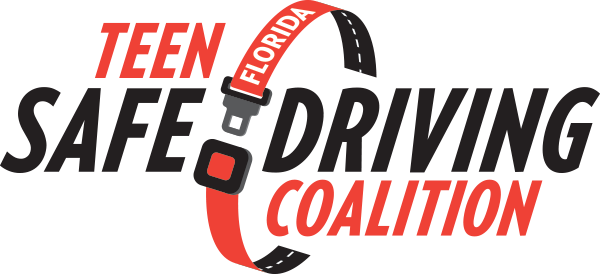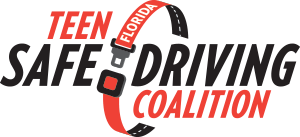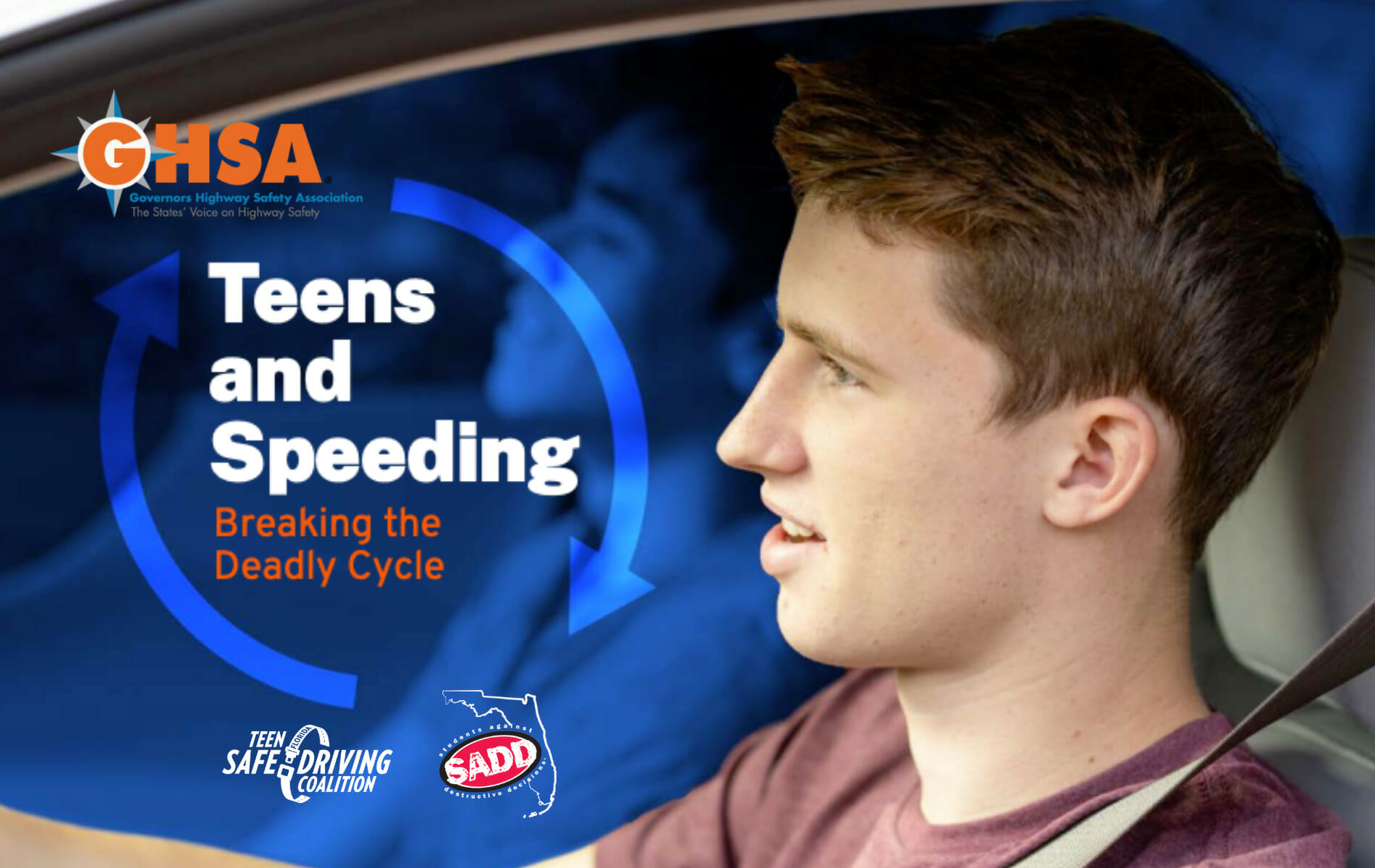
Teens and Speeding: Breaking the Deadly Cycle
The U.S. has a speeding problem. Driving at high rates of speed or too fast for conditions is one of the most prevalent factors contributing to serious and fatal crashes on our nation’s roadways.
Over the past five years (2015-2019), speeding has claimed the lives of approximately one-third of all people killed in motor vehicle crashes. While speeding is risky for all drivers, it is particularly problematic for teens 16 to 19 years of age. A closer look at the speeding data reveals a troubling and persistent trend—the proportion of fatal crashes that involved speeding was higher for teenage drivers than for other age groups (43% versus 30%).
Why the disparity? Teen drivers do not have the experience necessary to recognize and quickly react appropriately to dangerous situations, which makes speeding even riskier for them. This propensity to speed, however, is not innate. Teens learn about speeding at an early age, as they ride in vehicles driven by their parents and other adults and observe persistent speeding behavior. They are likely taught by driver education professionals and/or their parents that speeding is dangerous. But as teens gain confidence behind the wheel, their travel speeds are likely to increase and be exacerbated by other drivers on the road. For teens, like the adults they grew up riding with, keeping up with traffic—even if it requires going well over the speed limit—becomes the norm.
This report examines what we know about speeding-related teen driver fatal crashes—the driver was more likely to be male (37% versus 28%), have run-off the road or rolled over the vehicle and to be unbelted. While the youngest teen drivers (16-and 17-year-olds) have the highest fatal crash risk due to lack of experience, their older counterparts (18- and 19-year-olds) are more likely to crash later at night (midnight to 5 a.m.) and on highways and freeways. And when it comes to passengers, the risk of a teen driver being involved in a speeding-related fatal crash increases exponentially with each additional peer in the vehicle.
Breaking this deadly cycle is critical for driving down serious injuries and deaths involving teen drivers and their passengers. The good news is that this problem is not insurmountable. This report identifies some of the best no-tech, low-tech and high-tech resources (many of which are free) available to help families rein-in their speeding teens—and for parents to monitor their own driving speeds, as well. These include parent-teen driving agreements, state graduated driver licensing systems, peer-to-peer and parent-education programs, online training, and in-vehicle safety technology. Even a teenager’s cellphone can be tapped to deliver information to mom and dad about their speeding and other driving behaviors via free or low-cost apps. The key is convincing parents to not only learn about and leverage these resources, but also to recognize the danger speeding poses for their teen drivers and take appropriate action. The former is the job of the State Highway Safety Offices and their partners working in the teen driving arena, which is why this report includes recommendations directed specifically at them.
Introduction
Losing a child is, without a doubt, a parent’s worst nightmare. But sadly, each year there are parents in the United States (U.S.) that find themselves in the unimaginable position of making final arrangements for their teenage child killed in a motor vehicle crash, rather than organizing birthday parties or graduation celebrations. As shown in Figure 1, despite welcome declines in the number of traffic fatalities involving teenage drivers and passengers in 2018 and 2019, more than 2,000 U.S. teen vehicle occupant deaths occured each year. The data in this report come from the National Highway Traffic Safety Administration’s (NHTSA) Fatality Analysis Reporting System (FARS).

For all teen driver and passenger fatalities during that same 5-year period, 43% involved speeding. By comparison, 30% of fatalities involving drivers and passengers ages 20+ were speeding-related (Figure 2). A total of 4,930 teen drivers and passengers were killed in these speeding-related crashes. A state-by-state breakdown of teen driver and passenger fatalities for this 5-year period is provided in the Appendix.
According to the Centers for Disease Control and Prevention (CDC), motor vehicle crashes are the leading cause of death for U.S. teens1. The fatal crash rate per mile driven for 16-and 17-year-olds is about three times the rate for drivers 20 and older2. Based on police-reported crashes of all severities, the crash rate for 16-to 19-year-olds is nearly four times the rate for drivers 20 and older. Risk is highest at age 16.
In addition to having higher death rates, teen drivers pose a greater danger to others on the road. They pose the highest risk of death to their passengers, occupants of other passenger vehicles and non-vehicle occupants such as pedestrians and cyclists3.
Risk factors for teen crashes include inexperience, impulse control, lower seat belt use rates than other age groups4 and speeding. This report focuses on speeding.
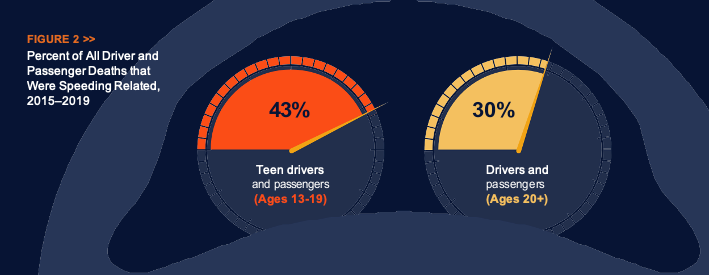
The U.S. has a speeding problem. Driving at high rates of speed or driving too fast for conditions is one of the most prevalent factors contributing to serious and fatal crashes for drivers of all ages. Speed limits are routinely violated and many drivers freely admit to speeding on a regular basis5. In recent years, many states have raised speed limits with some having maximum posted speed limits of 75 mph or higher. The result of higher speed limits is even higher vehicle speeds6.
Speeding increases both the likelihood of being in a crash and crash severity. Vehicles traveling at higher speeds cover a greater distance between the time a hazard is detected and the time the driver reacts, so the vehicle will travel farther before coming to a stop. Higher speeds also increase crash energy forces. This compromises a vehicle’s ability to protect occupants against serious and fatal injuries, even with substantial improvements in vehicle crashworthiness (e.g., steel reinforced safety cage, air bags, three-point seat belts, crumple zones). And even small increases in travel speed have significant, often deadly, consequences when a vehicle collides with a pedestrian or bicyclist.
While speeding is a risk factor for all drivers, teenagers (and other novice drivers) are at greater risk for serious crashes when speeding. Traveling at higher speeds or at speeds too fast for conditions reduces the amount of time drivers have to react to unforeseen dangers such as loss of control on slick pavement or a child or deer running into the road. Teen drivers are in the early stages of gaining the experience needed to recognize and get out of dangerous situations, which makes speeding even more risky.
Despite clear evidence of the harmful effects of speeding on fatal crashes, speeding by teen drivers continues to claim thousands of lives each year. This report provides the latest data on speed-related fatal crashes among teen drivers and evidence for their increased propensity to speed. It points to possible reasons for the speeding problem and suggests potential countermeasures as well as recommendations for possible implementation by the State Highway Safety Offices and their partners.
Size and Nature of the Problem
Speeding-related Fatal Crashes Among Teen Drivers
From 2015 to 2019, 15,510 teen drivers ages 16 to 19 were involved in fatal motor vehicle crashes. More than one-third of those crashes—5,202—involved speeding as documented in FARS.
Figures 3 and 4 illustrate the percentage of all speeding-related fatal crashes by driver age and gender for the five-year period. (Throughout the remainder of this report, passenger vehicle is referred to as vehicle.)
The youngest drivers (ages 16 to 19) had the greatest proportion of fatal crashes involving speeding (34%), followed closely by 20- to 29-year-old drivers (33%).
Male drivers in every age group account for the greatest proportion of fatal crashes involving speeding, although the disparity with female drivers diminishes with age. The youngest drivers (ages 16 to 19) of both sexes have the greatest proportion of fatal crashes involving speeding, with 36% of males and 28% of female teen drivers involved in these crashes.
In many speeding-related fatal crashes, drivers fail to keep their vehicles on the road. Roadway departure often results in high-speed collisions with trees, utility poles, culverts, parked cars and other roadside objects.
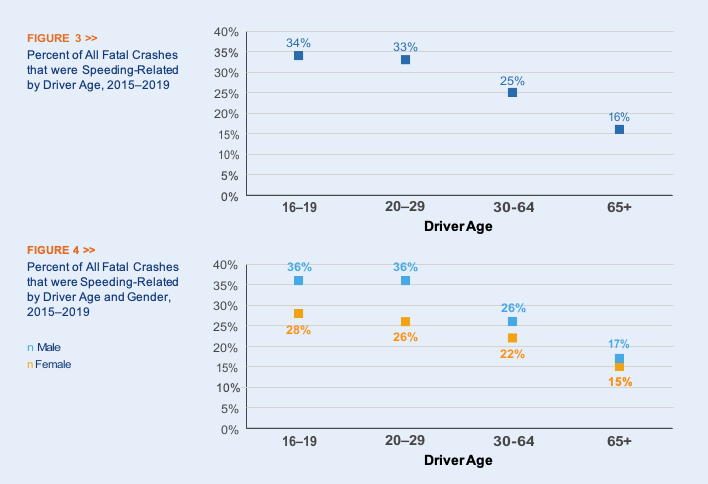
As shown in Figure 5, the youngest drivers (16- and 17-year-olds) had the highest percentage of fatal, speeding-related crashes resulting in roadway departure (71%), with the rate declining as drivers age. High levels of roadway departure for young drivers most likely reflects a lack of experience in selecting appropriate speeds for driving conditions and could also be associated with driver distraction and alcohol/drug impairment.
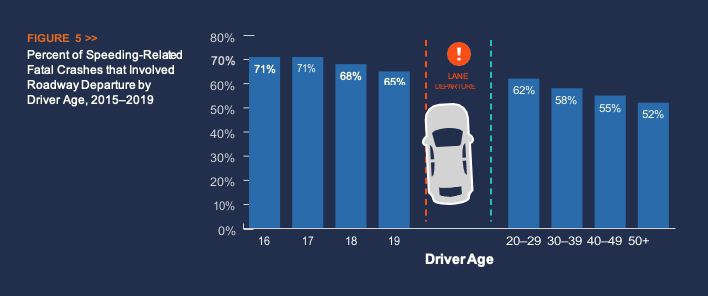
Another major risk factor in speeding-related crashes is vehicle rollover, which can be dangerous and deadly. As shown in Figure 6, the youngest drivers (16-year-olds) had the highest percentage of speeding-related fatal crashes involving rollover (41%), with a slight, gradual decline in the rate as drivers age. As with roadway departure, higher levels of young driver rollover crashes might reflect a lack of experience in selecting appropriate speeds for driving conditions, as well as inappropriate response to sudden changes in driving conditions at high speeds.
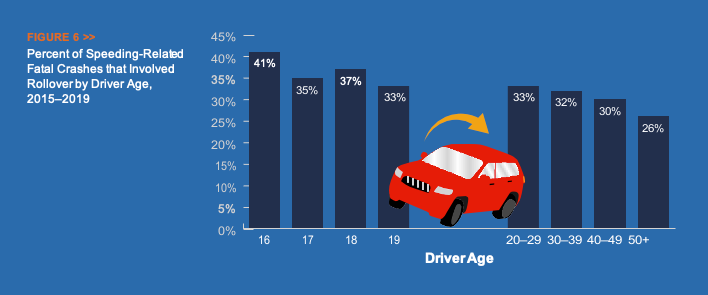
Driving after dark is riskier than daytime driving for several reasons, including higher travel speeds due to emptier roads, driver fatigue and a higher prevalence of alcohol impairment. As shown in Figure 7, the percent of speeding-related fatal crashes that occurred at night among teen drivers was lowest for 16-year-olds and increased with age. For 16- to 19-year-old drivers combined,
51% of all fatal crashes occurred in the dark. The increasing percent of nighttime crashes as teen drivers age is likely due to parental restrictions and/or state Graduated Driver License (GDL) laws limiting nighttime driving by the youngest novice teen drivers.
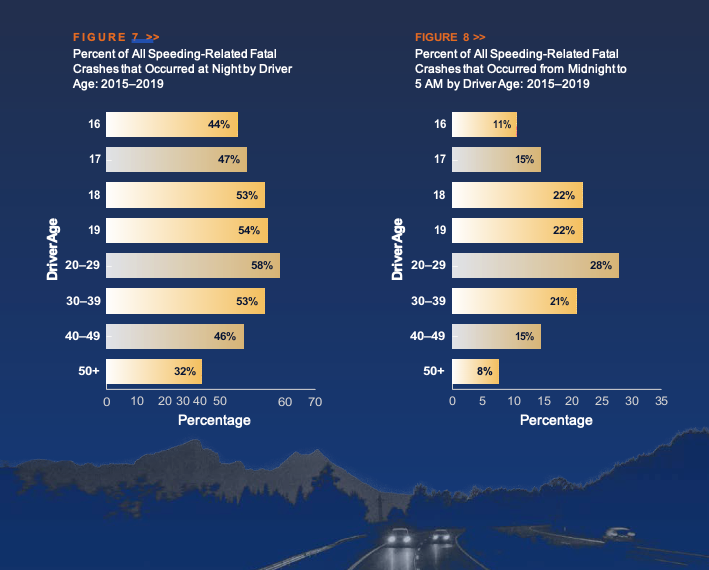
Similarly, late night hours, such as midnight to 5 a.m., can be particularly risky, especially for young drivers. As shown in Figure 8, the percent of speeding-related fatal crashes that occurred between this time period among teen drivers was also lowest for 16-year-olds and increased with age. As teens age and earn additional nighttime driving privileges, they are at increased risk of being involved in deadly late-night crashes.
All occupants of a vehicle should wear seat belts—on every trip. However, due to their higher-crash risk, it is especially important that teens always wear seat belts. Today’s teens grew up with car
seats and seat belts, which should make it natural for them to buckle up. Yet sadly, more than half of all teen drivers killed in speeding-related crashes were unrestrained. As Figure 9 shows, the number of unrestrained fatally injured teen drivers increased with age. This could be the result of exposure (e.g., number of licensed drivers by age, amount of time spent driving by age) and that teenagers typically feel more comfortable driving at higher speeds as they gain experience. This level of comfort may also result in lower seat belt usage rates as teenagers age. As shown in Figure 10, the percent of fatally injured teen drivers in speeding-related crashes that were unrestrained was lowest for 16-year-olds, and higher for 17-,18-, and 19-year-olds.
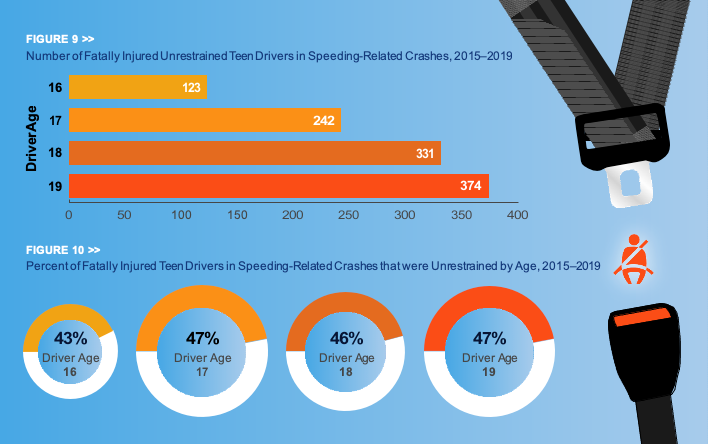
It is well known the presence of one or more teen passengers in a teen driver’s vehicle has been shown to negatively affect driver behavior and increase crash risk7. Teen passengers, for example, can goad the driver on or the driver could be showing off to friends. In some cases, passengers could physically interfere with the driver (e.g., grabbing the steering wheel). This problem is exacerbated with higher numbers of teen passengers in the vehicle. Figure 11 shows the percentage of teen driver (ages 16 to 19) speeding-related fatal crashes by teen passenger presence. For both male and female teen drivers, the rate of fatal crashes that were speeding- related increased with each additional teen passenger in the vehicle.
Understanding where teen drivers are speeding—the road type—is also important. Public roads generally fall into three categories: freeways such as interstates and limited access-highways; non-freeway arterials, typically the main roads that carry local and regional traffic through communities; and collector/local roads. Figure 12 shows the percentage of speeding-related fatal crashes by roadway category. Note that teen speeding is not confined to freeways. In fact, it is more likely to occur on non-freeway and local roads.

Interstates and other freeways have features that promote safety (e.g., median barriers to help prevent head-on collisions; elimination of intersections and crossing-path collisions through limited access), and speed limits and travel speeds are highest on these roadways, which can be a significant challenge for novice drivers. For this reason, many young drivers limit or delay driving on Interstates and other freeways, or travel more slowly than other drivers on these high-speed roads. As young drivers gain experience, they may be more willing to travel on Interstates and other freeways, and/or travel at higher speeds on these roads. This likely explains why the percent of all fatal crashes that occur on Interstates and other freeways increases steadily with driver age through the teen years.
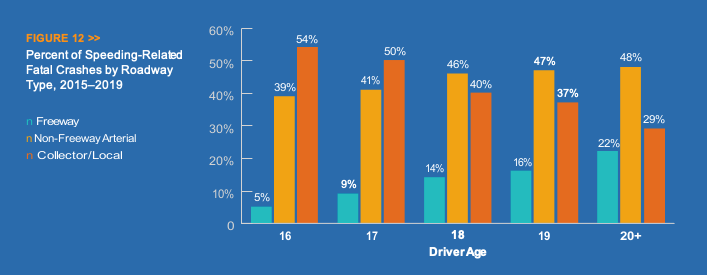
Why the Problem Exists
Elevated crash rates for teen drivers result both from inexperience and immaturity. Young drivers are still learning critical driving skills that experienced drivers take for granted. And teenagers are still developing physically, mentally and emotionally. Lack of experience behind the wheel makes it more difficult for teenagers to assess potential crash risks, such as speeding, as well as to recognize and respond to hazards when they occur. While the relative contribution of driver age versus inexperience has long been debated, the effects of experience are clearly demonstrated by a steep drop in crash rates, especially among the youngest drivers, during the first few months of driving8.
Developmental Issues
Adolescents’ brains differ from those of adults in important ways. Higher teen driver death rates are reported to be related to problems with behavior and emotion control9. The human brain isn’t fully developed until the early to mid-twenties, particularly the prefrontal cortex where impulse control, decision making and judgment are centered, thus compromising important functions related to safe driving. Some teenagers may also be impulsive, thrill seeking and more drawn to the rewards of risky behavior rather than wary of the negative consequences of such behaviors.
Driver Skills and Driving Behavior
Learning to drive safely takes time and extended practice, regardless of age. Many skills must be mastered. New drivers usually learn maneuvering skills such as steering, accelerating and braking relatively quickly. Meanwhile, more complex tasks such as visual search, risk and hazard perception, and appropriate responses to the latter, come with practice over a longer time period.
Novice drivers’ attention can be easily overloaded such that their ability to pay attention to multiple activities on the road (e.g., pedestrians and cross traffic) is limited. There is evidence novice drivers are less able to assess hazards in the traffic environment and their visual search patterns are less attuned to detect potential future risks10. Observational studies have documented the tendency for teen drivers to speed and allow shorter following distances11 12. These risky behaviors are exacerbated in the presence of teen passengers.
Reducing the Problem
One of the biggest challenges in addressing the dangers of speeding is that this behavior is widely accepted nationwide. The U.S. has a culture of speeding in which many drivers view speed limits as minimums rather than the maximums based on ideal conditions. According to the “2019 AAA Safety Culture Index,” 48.3% of motorists reported exceeding the posted speed limit by 15 mph on highways, while 41.5% admitted driving 10 mph over the posted speed limit on residential streets in the past month13. The latest speed research conducted for NHTSA confirms what the motoring public admits: 68% are exceeding the posted speed limit on limited access roads and 56% and 58% are doing so on arterials and collectors, respectively.

The U.S. has a culture of speeding in which many drivers view speed limits as minimums rather than the maximums.
Approximately 16% to 19% of these motorists are also traveling more than 10 mph over the posted speed limit14.
Although speeding has long been recognized as a critical factor contributing to fatal teen crashes, effective measures to reduce the problem have been elusive. Potential countermeasures include driver training, safety education, state GDL laws that set a minimum age at which teens may obtain a driving permit and license and restrictions on when teens can drive and with whom, speed enforcement, and a growing array of in-vehicle technologies. The remainder of this report addresses various approaches to help reduce the teen speeding-related crash problem and recommendations for consideration by the SHSOs.
Speed Limits and Speed Enforcement
Speed limits and their enforcement have the potential to deter teen drivers from speeding, but most law enforcement agencies have insufficient staffing resources to conduct rigorous, sustained speed enforcement campaigns. In addition, some law enforcement officials believe public concerns about perceived racism in traffic enforcement might be a factor in the apparent slowdown in traffic enforcement by police15. Although police speed enforcement activities do not specifically target drivers by age, law enforcement agencies could conduct periodic speed enforcement at crash- prone locations frequented by younger drivers, such as near high schools or shopping malls.
While automated traffic enforcement (e.g., safety cameras) has been shown to dramatically reduce speeding behavior16, many states either prohibit this technology, do not expressly authorize its use, or restrict cameras to school and/or work zones.
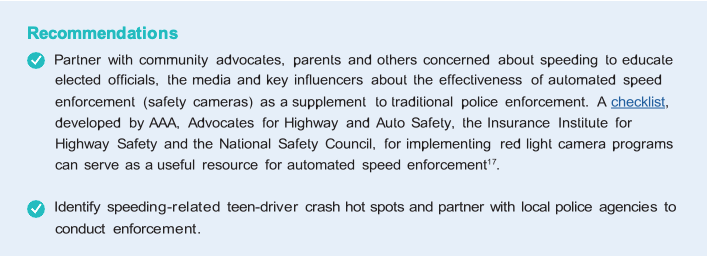
Driver Education and Training
Beginning drivers need training to learn basic driving skills, as well as to master more advanced techniques over time. Driver education enjoys widespread public support as the preferred way to prepare teenagers for driving. There is mixed evidence regarding the effectiveness of traditional driver training in reducing crashes among young drivers. Several comprehensive international reviews of the best scientific evaluations of driver education programs for young beginners concluded there is no difference in the crash records of driver education graduates compared with equivalent groups of beginners who learned to drive without formal education18.
Newer research conducted in Nebraska, however, investigated whether teens who obtained their intermediate-level provisional operators permit (POP) in a GDL environment through driver education had fewer crashes and traffic violations then teens who obtained their POP by completing a supervised driving certification log in lieu of taking driver education. A descriptive epidemiological study examining a census of all 151,880 teen drivers in Nebraska from 2003 to 2010 found the driver education cohort had significantly fewer injury and fatal crashes and violations than the certification log cohort during the first two years of driving following receipt of their POP19.
In partnership with the American Driver and Traffic Safety Education Association, GHSA and several other safety-related organizations, NHTSA developed driver training curricula and administrative standards. NHTSA also developed a driver education program assessment tool to help states conduct a comprehensive review of their education and training programs to determine where improvements can be made.
Computer-based curriculum provides another option for delivering teen driver education and training with more consistency and convenience, though safety outcomes vary. For example:
» Researchers tested a stand-alone, self-administered training module intended to accelerate the process of perceptual expertise for young, novice drivers among a small sample of young drivers20. Five out of the six pilot-study participants demonstrated robust improvements in all learning categories included in the training –path conflict, stopping vehicle, roadside incursion, forced path change, obscured potential hazard and emergency vehicle effects. While this approach appears promising, the study did not examine the training’s effect on actual driving skills or crash risk and whether these effects are long-lasting.
» Researchers developed and evaluated Accelerated Curriculum to Create Effective Learning (ACCEL), a computer-based training program that can be downloaded from the Internet on any personal computing device (e.g., laptops, smartphones, tablets)21. The program targeted six skills based on a literature review of factors linked to novice driver crash risk. The researchers found the ACCEL training group performed better than the placebo training group in five of the six skills, with tactical hazard mitigation performance marginally better for the ACCEL group as compared to the placebo group. The study also examined whether the skills were sustained three to six months post-training and the effects of a second ACCEL training session. Findings, however, were limited due to high participant attrition. Overall, the ACCEL training program accelerated the development of novice drivers’ strategic and tactical hazard anticipation and attention maintenance skills across the riskiest crash scenarios.

» Ford Driving Skills for Life offers The Academy, a free online resource to help teens “test [their] safe driving knowledge and gain valuable safe driving skills.” The Academy also includes a Parent-Teen Driver Agreement (see page 19 for more information on this proven tool), and science-based resources that use algebra and biology to reinforce critical traffic safety concepts22.
A number of high-performance driver training programs are available for parents that want to expose teens to emergency driving exercises such as hard braking, emergency lane change and slide recovery, and skid control, as well as cognitive skills like hazard anticipation, visual scanning and situational awareness.

Graduated Driver Licensing
Graduated Driving Licensing (GDL) is widely recognized as one of the most effective approaches for reducing the risk of teen crashes. GDL restricts teen driving to times of the day and situations that are considered lower risk. According to NHTSA, this approach can reduce teen crash risk by as much as 50%23. GDL addresses well-known high risks for novice drivers by limiting driving at night and with teen passengers during the initial six to 12 months of licensure, only allowing unrestricted driving after more experience has been gained.
GDL restricts teen driving to times of the day and situations that are considered lower risk. This approach can reduce teen crash risk by as much as 50%.
The effects of GDL specifically on teen speeding behavior have not been established by research. But limiting driving under conditions for which speeding is known to be more prevalent — at night (when roads are emptier) and with teen passengers –is critical and both restrictions are shown to reduce teen crash risk. Stronger GDL laws lead to the greatest crash reductions24. GHSA maintains a list of current state GDL laws.
Some states do not allow teen drivers to advance from one phase of GDL to another if they have been convicted of certain traffic violations such as racing and reckless driving. Penalties for serious traffic offenses committed by teen drivers in some states include license suspension, which temporarily takes away driving privileges and delays advancement through the GDL process.

Parents’ Role
Beyond government laws and restrictions, parents can take an active role in helping to reduce teen crashes. The following noteworthy approaches are available to families of teen drivers.
In-vehicle Driver Monitoring
Many parents worry about how safely their teens are driving when they’re unsupervised. When asked about their specific concerns, the number one issue for parents was speeding. More than half said they’d want to know if their teen was speeding25.
Fortunately, a growing number and variety of aftermarket devices are available that employ computer chips, GPS systems and video-based recorders to assist parents in monitoring and controlling teen driving behavior. There is some evidence that in-vehicle monitoring of novice teen drivers can result in less risky driving26 27. Whether in-vehicle monitoring can be an effective countermeasure depends on whether teens change their driving behavior.
For that to happen, parents need to be engaged and use the information provided by these systems to coach their teen drivers. However, parents’ interest in checking on their teens’ driving behavior is not universal and diminishes over time28, which reduces the potential effectiveness of in-vehicle driver monitoring.
In addition to aftermarket devices, some vehicle manufacturers offer equipment that allows parents to limit certain types of teen driving behavior. For example:
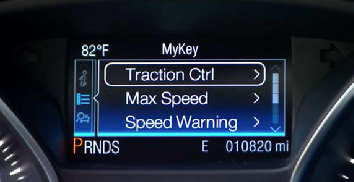
» Ford’s MyKey© Technology is a standard feature on all Ford and Lincoln models that offers a special teen driver key parents can program to limit the vehicle top speed to 80 mph and provide audible warnings at speeds of 45, 55 and 65 mph29. MyKey also includes a “Belt-Minder” that not only chimes but mutes the vehicle’s audio speakers until the driver is buckled up. According to Ford, parents of teen drivers are supportive of the technology, with 75% saying they like the speed limiting feature. Systems such as MyKey have the potential to reduce speeding-related crashes, although no studies have examined their effectiveness.
» Volvo offers Care Key in-car technology in 2021 models, which is aimed at addressing speeding. With Care Key, Volvo owners can apply a speed cap when younger family members or less experienced drivers are behind the wheel. Also, starting with all 2020 models, Volvo capped its top vehicle speed at 112 mph.
» Chevrolet offers Teen Driver Technology, a built-in system that allows parents to set a speed alert and limit the top speed to 85 mph, set a volume limit that includes muting the audio until the driver and front seat passenger are buckled up, and receive the industry’s first and only in-vehicle report card. Parents can use this information to identify potential problem areas and provide guidance.
Smartphone Apps
Although cellphone use behind the wheel is strongly discouraged, and is generally restricted or prohibited, smartphone apps have been developed to support safe driving behavior. The prevalence of cell phone use among teen drivers presents an opportunity for parents to use a growing number of smartphone apps to keep tabs on how teens are driving and supports parents’ efforts to discourage unsafe teen driving behaviors, including:
» Life360 is designed to keep families connected by providing parents the ability to monitor teen driving in real time. The app includes a driver safety mode that can track locations and monitor speed, and send text message alerts for hard braking, rapid acceleration and even crashes30.
» Built into specific models, the Hyundai Blue Link app enables parents to set custom, pre-set notifications that tell them when their teens exceed the speed limit31.
» Bouncie provides parents access to real-time driving insights, including notifications for speed, acceleration, hard braking, idle time and more32. Events for each trip are summarized and available for review anytime, giving parents the ability to monitor their teens’ safe driving progress overtime.
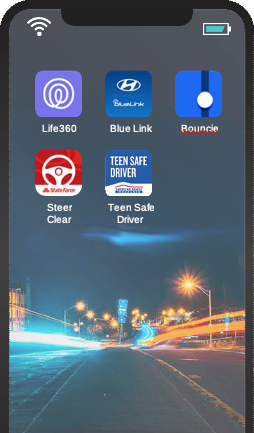
» State Farm offers the app-based Steer Clear discount program for teens, which is promoted as a way for “teen and young adult drivers to improve their driving skills and earn a discount” on auto insurance33.
» American Family Insurance’s Teen Safe Driver app monitors teen drivers’ risky behaviors and sends alerts to their smartphones. Parents also have the app on their phones, enabling them to keep an eye on their novice driver and
take corrective action as necessary. Insured families receive a 10% discount after their teens complete 3,000 miles or one year in the program34.
In-Vehicle Safety Technology
When purchasing a new vehicle or deciding which family vehicle should be driven by teen drivers, parents should consider the role of in-vehicle safety technologies. These include:
» Lane-keeping assist, which provides feedback to drivers when straying out of the travel lane.
» Automatic emergency braking, which automatically activates the vehicle’s brake system, to some degree, when necessary.
» Adaptive cruise control, which automatically adjusts vehicle speed to maintain a safe distance from vehicles ahead.
» Speed limit recognition, which can warn drivers when they’re exceeding the speed limit.
These advanced safety features are available on many vehicles as either standard or optional equipment.
It is important to note safety technologies such as those described above are intended to support—not serve as a substitute for—a safe and engaged driver nor are they a substitute for parental involvement in the teen driver learning and skill building process. The use of driver monitoring devices requires candid conversations between parents and teens. It is important they agree on the role of these technologies in reinforcing safe driving behaviors and habits, which should have already been taught to teen drivers by their parents and driving instructors. Safety technologies can serve as guardrails to remind teens in real-time when their driving actions or decisions are putting them at risk. It also is important for parents to learn how their vehicles’ safety features work and to convey this information to their teen drivers. This goes for smartphone apps, as well. But most importantly, parents should regularly reinforce with their teens that a safe driver is a vehicle’s most important and effective safety feature.
In-vehicle safety technology is intended to support
— not serve as a substitute for — a safe and engaged driver.

Parental Involvement in the Learning-To-Drive-Process

Many programs are available to help parents better understand the risks for their novice drivers and what they can do and use to help address those risks. Some examples include learning about and enforcing GDL requirements including developing a parent-teen driving agreement, coaching and monitoring their teens, being positive role models and controlling the car keys. Because today’s parents learned to drive under very different conditions and with far less prescriptive driver licensing laws, educational programs are key to encouraging informed parental involvement. Some states, nonprofits and insurance companies have developed and/or fund parent education/orientation programs
that show promise in engaging parents and teens to work together as the latter get behind the wheel35.
Research conducted on the effectiveness of teen driving parent education/orientation program identified the following key components for success36:
» Be evidence-based and grounded in research
» Provide clear guidance for parent action
» Have repeated contacts with parents
» Incorporate principles of adult learning
» Explain the rationale for GDL and the role of parents
» Be designed and conducted by individuals outside the driver education system
» Have systems in place to ensure the program is standardized and delivered consistently
» Evaluate outcomes
» Mandate parent attendance
Some of these programs address the critical role parents play in controlling the keys, which involves making (sometimes) tough decisions about when teenagers are not allowed to drive the family vehicle. Vehicle ownership is also a factor to consider. Teens often drive smaller and older vehicles that offer less protection than larger and newer vehicles in a crash. Several studies have shown that teens considered to be the primary owner of a vehicle are more likely to speed37 38, so parents should think carefully about providing teens their own vehicle when first licensed.

This parent involvement is important. Research from The Children’s Hospital of Philadelphia found that teenage drivers with authoritative (actively involved) parents were half as likely to be involved in a crash, 71% less likely to drive intoxicated, and 30% less likely to use a cell phone when driving compared to teens with uninvolved parents. These same teens were also 50% more likely to buckle up and recognize why doing so is important39. Authoritative parents provide a warm supportive environment with clear boundaries giving them enough structured support to allow them to make good choices.

Modeling Safe Driving Behavior
The behavior and actions of parents can have significant influence over their children’s driving behavior. Teenagers learn from watching their parents. Parents are their teens’ first driving teacher and coach and their biggest influencer. Research shows that teens welcome their parents’ involvement, citing their parents as the number one influence when it comes to learning to drive40.
It is important for parents to model safe driving behavior and be consistent in the messages they tell their teens versus their own driving behaviors. By not speeding, driving aggressively or driving distracted or impaired, parents can model the type of safe driving behavior they expect their teen drivers to exhibit.
Modeling safe driving behavior includes slowing down during inclement weather. New teen drivers need to learn how vehicles react in inclement weather and may not appreciate the risks of driving in rain, fog, ice and/or snow. Parents teaching their teens how to drive should take them out on a rainy or snowy day and let them learn how vehicles react with less traction and how reducing speed can help them better maintain control on slick road surfaces.

Parent-Teen Driving Agreements
Conversations between parents and teens about safety can help ensure teens make better decisions behind the wheel. Parent-teen driving agreements serve as a tool to prompt discussion and ongoing dialogue about safety. Researchers at the CDC and other safety and health-related organizations strongly recommend parents use an agreement that clearly outlines the rules of the road with their new drivers41. Examples of parent-teen driving agreements (PTDA) are available online and most cover the key risk factors for teens including driving at night, passengers, cell phones and texting, seat belts, and the use of alcohol. At minimum, a PTDA should outline the provisions in a state’s GDL and other motor vehicles laws including obeying speed limits, and the consequences for violating them.

Peer-to-Peer Programs
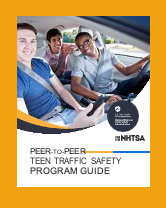
In addition to learning safe driving behaviors and habits from parents and driving instructors, teens can be encouraged by their peers to act safely and responsibly behind the wheel. Because teens who regularly participate in positive social projects designed to help their peers and others are less likely to engage in risky behaviors42, peer-to-peer traffic safety programs are an important part of a broader strategy for preventing teen driver crashes and the resulting injuries and fatalities. NHTSA partnered with GHSA to publish a comprehensive Peer-to-Peer Teen Traffic Safety Program Guide that can support community efforts to establish effective peer-to-peer teen driver safety programs43.

Conclusion
While speeding is a risk factor for all drivers, teenagers are at greater risk for serious crashes when speeding. Analyses of fatal crash data confirm the significant role speeding plays in teen driver crashes:
» Among all age groups, teen drivers—of both sexes—have the greatest proportion of fatal crashes involving speeding, with 36% of males and 28% of female teen drivers involved in these crashes.
» Teen drivers have the highest percentage of speeding-related fatal crashes that resulted in roadway departure (71%) or rollover (41%).
» More than half of teen speeding-related fatal crashes occurred at night; 20% occurred between midnight and 5 a.m.
» More than half of all teen drivers killed in speeding-related crashes were not wearing seat belts.
» The percent of fatal crashes that were speeding-related increased with each additional teen passenger in the vehicle.
Inexperience and immaturity place teen drivers at greater risk of being involved in a fatal crash. In addition, some teens lack impulse control and engage in risky behavior such as speeding. Higher speeds increase both the likelihood of being in a crash and of being seriously injured or killed. Yet the issue of speeding among teen drivers—and for drivers of all ages—does not garner as much attention as other risk factors such as distracted, alcohol or drug impaired driving or have the same social stigma. Increases in posted speed limits on some roads to 75 mph, 80 mph and even 85 mph have sent the wrong message that high speeds are safe and acceptable.
Despite the proven benefits of GDL, speeding-related teen crash rates remain high. Parents play a critical role in their teens’ safety and are generally supportive of restrictions on their novice drivers when first licensed. Parents can be instrumental in decisions about when teens first get their licenses and what, where, when and how often they may drive the family vehicle.
There is clear evidence that young drivers speed more in the presence of their friends, so passenger restrictions are particularly important. Limiting the number of teens (and siblings) has been shown to reduce crashes, but there are still many fatal crashes involving teen drivers transporting their peers.
Parents are concerned about their teens’ speeding behavior and are key to making a difference. Impactful actions parents can take to reduce both teen speeding behavior and the risk of severe crashes include:
» Getting—and staying—intimately involved in the learning-to-drive-process.
» Supplementing traditional driver education and training with plenty of supervised behind the wheel practice as well as online tools, hands-on events and other resources.
» Consistently modeling safe driving behavior.
» Establishing and enforcing rules about when their teens may drive and with whom.
» Ensuring the vehicles teens have access to are equipped with driver assist technologies.
» Using in-vehicle driver monitoring to track teen driving behavior and provide feedback regarding speeding to promote the adoption of safe driving habits.
In addition to learning safe driving behaviors from parents and driving instructors, peer-to-peer traffic safety programs are an important part of a broader strategy for preventing teen driver crashes and the resulting injuries and fatalities.
Speeding is pervasive among drivers of all ages and a major contributing factor in all fatal crashes. Teens learn to speed because it is the normalcy they observe and what becomes expected of them when driving in traffic, regardless of what they are taught by parents or instructors. It is hard for teens to adhere to or fully respect speed limits and other best safety practices when they do not comport with the everyday driving experience. For these reasons, achieving progress in reducing teen speeding-related crashes and fatalities has been a significant challenge. The variety of tools and resources presented in this report provide the best available approaches to support parents’ efforts to reduce teen speeding behavior and crashes.
References
- Centers for Disease Control and Prevention. Teen Drivers: Get the Facts. https://www.cdc.gov/motorvehiclesafety/teen_drivers/teendrivers_factsheet.html Accessed 11-25-2020.
- Insurance Institute for Highway Safety (2020). Teenagers. https://www.iihs.org/topics/teenagers Accessed 11- 25-2020.
- Braver, E.R. & Trempel, R.E. (2004). Are older drivers at higher risk of involvement in collisions resulting in deaths or non-fatal injuries among their passengers and other road users? Injury Prevention, 10, 27-32.
- Enriquez, J. (2019). Occupant restraint use in 2018: Results from the NOPUS controlled intersection study (Report No. DOT HS 812 781). Washington, DC: National Highway Traffic Safety Administration.
- Schroeder, P., Kostyniuk, L., & Mack, M. (2013). National survey of speeding attitudes and behaviors (Report No. DOT HS 811 865). Washington, DC: National Highway Traffic Safety Administration.
- Retting, R.A. & Cheung, I. (2008). Traffic speeds associated with implementation of 80 mph speed limits on rural interstates in West Texas. Journal of Safety Research 39: 529–534.
- Williams, A.F., Ferguson, S.A., & McCartt, A.T. (2007). Passenger effects on teenage driving and opportunities for reducing the risks of such travel. Journal of Safety Research, 38: 381-390.
- Mayhew, D.R., Simpson, H.M., & Pak, A. (2003). Changes in collision rates among novice drivers during the first months of driving. Accident Analysis and Prevention, 35: 683-691.
- National Research Council. (2007). Preventing teen motor crashes: Contributions from the behavioral and social sciences. Washington, DC: National Research Council, Institute of Medicine, and Transportation Research Board of the National Academies.
- Ferguson, S.A. (2003). Other high-risk factors for young drivers –how graduated licensing does, doesn’t, or could address them. Journal of Safety Research, 34: 71-77.
- Simons-Morton, B., Lerner, N., & Singer, J. (2005). The observed effects of teenage passengers on the risky driving behavior of teenage drivers. Accident Analysis and Prevention, 37: 973-982.
- Goodwin, A.H., Foss, R.D., & O’Brien, N.P. (2012). The effect of passengers on teen driver behavior. (Report No. DOT HS 811 540). Washington, DC: National Highway Traffic Safety Administration.
- AAA Foundation for Traffic Safety. (2020, June). 2019 AAA Traffic Safety Culture Index, Washington, DC.
- DeLeonardis, D., Huey, R., & Green, J. (2018, March). National traffic speeds survey III: 2015. Washington, DC: National Highway Traffic Safety Administration. https://www.nhtsa.gov/sites/nhtsa.dot.gov/files/ documents/812485_national-traffic-speeds-survey-iii-2015.pdf
- Kunkle, F. (2016, Oct. 5). Is Ferguson effect making nation’s highways unsafe? Some safety officials think so. Washington Post.
- Retting, R.A., Kyrychenko, S., & McCartt. A.T. (2008). Evaluation of automated speed enforcement on Loop 101 in Scottsdale, Arizona. Accident Analysis and Prevention 40:1506-1512.
- AAA, Advocates for Auto & Highway Safety, Insurance Institute for Highway Safety, and National Safety Council (2018). Red light camera program checklist. https://www.iihs.org/media/1c936880-1816-44fe-ab57- df603ad15714/ZjmPNA/News/2018/072418/RLC-program-checklist.pdf33333 Accessed 11-25-2020.
- Williams, A.F., & Ferguson, S.A. (2004). Driver education renaissance? Injury Prevention: 10: 4-7.
- Shell, D.F., Newman, I.M., Córdova-Cazar, A.L., & Heese, J.M. (2015). Driver education and teen crashes and traffic violations in the first two years of driving in a graduated licensing system. Accident Analysis & Prevention Volume 82: 45-52.
- Lerner, N., Gill, M., Kellman, P.J., Burke, T., Older, R.M., & Scott-Parker, B. (2017). Development of a novice driver training module to accelerate driver perceptual expertise. Washington, DC: AAA Foundation for Traffic Safety.
- Fisher, D.L., Young, J., Zhang, L., Knodler, M., & Samuel, S. (2017). Accelerating teen driver learning: anywhere, anytime training. Washington, DC: AAA Foundation for Traffic Safety.
- Ford Driving Skills for Life. https://www.drivingskillsforlife.com/resources Accessed 11-25-2020.
- NHTSA Teen Driving webpage: https://www.nhtsa.gov/road-safety/teen-driving Accessed 9-17-2020
- McCartt, A.T., Teoh, E.R., Fields, M., Braitman, K.A., & Hellinga, L.A. (2010). Graduated licensing laws and fatal crashes of teenage drivers: A national study. Traffic Injury Prevention, 11: 240-248.
- McCartt, A.T., Hellinga, L.A., & Haire, E.R. (2007). Age of licensure and monitoring teenagers’ driving: Survey of parents of novice teenage drivers. Journal of Safety Research, 38: 697-706.
- Farmer, C.M., Kirley, B.B., & McCartt, A.T. (2010). Effects of in-vehicle monitoring on the driving behavior of teenagers. Journal of Safety Research, 41: 39-45.
- Simons-Morton, B.G., Bingham, C.R., Claude Ouimet, M., Pradhan, A.K., Chen, R., Barretto, A., & Shope, J.T. (2013). The effect on teenage risky driving of feedback from a safety monitoring system: A randomized controlled trial. Journal of Adolescent Health [online article], 1-6. https://pubmed.ncbi.nlm.nih.gov/23375825/
- Carney, C., McGehee, D.V., Lee, J.D., Reyes, M.L., & Raby, M. (2010). Using an event-triggered video intervention system to expand the supervised learning of newly licensed adolescent drivers. American Journal of Public Health, 100:1101e6.
- Ford Motor Company MyKey Feature. https://owner.ford.com/support/how-tos/technology/keys/how-to-use-my- key.html Accessed 11-25-2020.
- Life360. https://www.life360.com/features-driving-safety/ Accessed 11-25-2020
- Hyundai Motor Company Blue Link® Connected Car Service. https://www.hyundaiusa.com/us/en/blue-link Accessed 11-25-2020.
- Bouncie. https://www.bouncie.com/ Accessed 11-25-2020.
- State Farm Insurance Steer Clear® Safe Driver Discount. https://www.statefarm.com/insurance/auto/discounts/steer-clear Accessed 11-25-2020
- American Family Insurance Safe Driver Discount Program for Teens https://www.amfam.com/insurance/car/teensafedriver Accessed 11-25-2020.
- Fischer, P.S. (2013). Promoting parent involvement in teen driving. Washington, DC: Governors Highway Safety Association.
- Goodwin, A.H., Harrell, S., Foss, R., O’Brien, N.P., Kirley, B.B., & Wang, Y. (2018). Orientation sessions for parents of young novice drivers: An assessment of U.S. programs and recommendations. Washington, DC: AAA Foundation for Traffic Safety.
- Cammisa, M.X., Williams, A.F., & Leaf, A.L. (1999). Vehicles driven by teenagers in four states. Journal of Safety Research, 30: 25-30.
- Klauer, S.G., Simons-Morton, B., Lee, S.E., Ouimet, M.C., Howard, E.H., & Dingus, T.A. (2011). Novice drivers’ exposure to know risk factors during the first 18 months of licensure: The effect of vehicle ownership. Traffic Injury Prevention, 12: 159-168.
- The Children’s Hospital of Philadelphia Center for Injury Research & Prevention (2009). Driving through the eyes of teens a closer look, second in a series of teen driver safety issues. https://www.teendriversource.org/ Accessed 11-25-2020.
- The Allstate Foundation (2015). Our journey to safer teen driving, 2015 data summary. Northbrook, IL. https:// www.allstate.com/resources/allstate/attachments/pdf/2015-chronic-taf-tsd-history.pdf Accessed 11-25-2020.
- US Centers for Disease Control and Prevention. Parent-Teen Driving Agreement https://www.cdc.gov/parentsarethekey/agreement/index.html Accessed 11-25-2020.
- Varenhorst, B.B. (2004). Tapping the power of peer helping. Reclaiming children and youth. The Journal of Strength-based Interventions 13(3): 130-133.
- Fischer, P. (2019). Peer-to-peer teen traffic safety program guide (Report No. DOT HS 812 631). Washington, DC: National Highway Traffic Safety Administration.
Appendix 1
Teen Driver and Passenger Fatalities and Speeding-Related Fatalities by State, 2015–2019
| State | Total Teen Fatalities | Speeding-Related Fatalities | % Speeding-Related |
| Alabama | 363 | 143 | 39% |
| Alaska | 26 | 13 | 50% |
| Arizona | 272 | 140 | 51% |
| Arkansas | 172 | 58 | 34% |
| California | 979 | 453 | 46% |
| Colorado | 213 | 122 | 57% |
| Connecticut | 72 | 39 | 54% |
| Delaware | 30 | 15 | 50% |
| District of Columbia | 5 | 4 | 80% |
| Florida | 789 | 163 | 21% |
| Georgia | 468 | 132 | 28% |
| Hawaii | 30 | 25 | 83% |
| Idaho | 96 | 25 | 26% |
| Illinois | 335 | 197 | 59% |
| Indiana | 320 | 127 | 40% |
| Iowa | 154 | 43 | 28% |
| Kansas | 167 | 88 | 53% |
| Kentucky | 223 | 73 | 33% |
| Louisiana | 237 | 76 | 32% |
| Maine | 42 | 30 | 71% |
| Maryland | 130 | 65 | 50% |
| Massachusetts | 95 | 51 | 54% |
| Michigan | 312 | 138 | 44% |
| Minnesota | 120 | 43 | 36% |
| Mississippi | 272 | 55 | 20% |
| Missouri | 374 | 227 | 61% |
| Montana | 86 | 38 | 44% |
| Nebraska | 115 | 27 | 23% |
| Nevada | 81 | 41 | 51% |
| New Hampshire | 35 | 27 | 77% |
| New Jersey | 116 | 58 | 50% |
| New Mexico | 102 | 59 | 58% |
| New York | 227 | 143 | 63% |
| North Carolina | 436 | 214 | 49% |
| North Dakota | 37 | 14 | 38% |
| Ohio | 408 | 145 | 36% |
| Oklahoma | 237 | 93 | 39% |
| Oregon | 124 | 71 | 57% |
| Pennsylvania | 344 | 234 | 68% |
| Rhode Island | 18 | 12 | 67% |
| South Carolina | 275 | 157 | 57% |
| South Dakota | 57 | 26 | 46% |
| Tennessee | 334 | 91 | 27% |
| Texas | 1,212 | 534 | 44% |
| Utah | 114 | 39 | 34% |
| Vermont | 18 | 10 | 56% |
| Virginia | 244 | 120 | 49% |
| Washington | 163 | 71 | 44% |
| West Virginia | 89 | 42 | 47% |
| Wisconsin | 200 | 91 | 46% |
| Wyoming | 51 | 28 | 55% |
| Total | 11,419 | 4,930 | 43% |
Source: FARS
Appendix 2
Teen Driver and Passenger Fatalities and Speeding-Related Fatalities by State Sorted by Number, 2015–2019

Acknowledgments
Richard Retting, Sam Schwartz Consulting, researched and wrote the report in consultation with Pam Shadel Fischer, GHSA Senior Director of External Engagement.
Russ Martin, GHSA Senior Director of Policy and Government Relations, and Kerry Chausmer, GHSA Director of Programs and Member Services, edited the report. Jonathan Adkins, GHSA Executive Director, oversaw the report.
Creative by Brad Amburn. This report is made possible with support from Ford Motor Company Fund.
Published January 2021


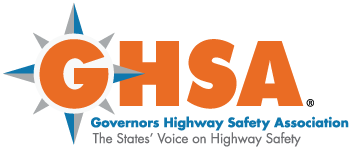
The Governors Highway Safety Association (GHSA) is a nonprofit association representing the highway safety offices of states, territories, the District of Columbia and Puerto Rico. GHSA provides leadership and representation for the states and territories to improve traffic safety, influence national policy, enhance program management and promote best practices. Its members are appointed by their Governors to administer federal and state highway safety funds and implement state highway safety plans.
View the original source: https://www.ghsa.org/resources/Teens-and-Speeding-Report21
